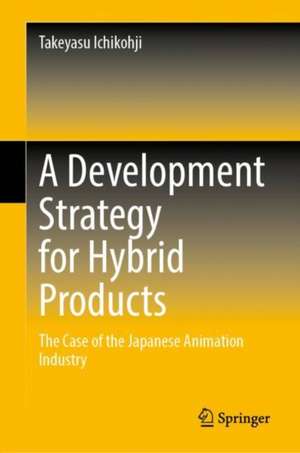A Development Strategy for Hybrid Products: The Case of the Japanese Animation Industry
Autor Takeyasu Ichikohjien Limba Engleză Hardback – noi 2021
The study was conducted in two stages. The first stage was to determine the engineers’ (animators’) perception of hybrid technology. The results showed that in terms of potential, the hybrid technology of hand-drawn animation combined with 3DCG was rated more highly by engineers than hand-drawn alone. However, in terms of the assessment at that time, hybrid technology was rated higher than 3DCG alone but lower than hand-drawn. Therefore, it was assumed that hybrid technology, while useful, would pose challenges with respect to systematic implementation. The second stage was the development management of hybrid products. The results showed that the "adaptive engineer," who openly accepts other new technologies in the early stages of their emergence contributed to the integration of new and existing technologies.
| Toate formatele și edițiile | Preț | Express |
|---|---|---|
| Paperback (1) | 691.12 lei 43-57 zile | |
| Springer Nature Singapore – 2 noi 2022 | 691.12 lei 43-57 zile | |
| Hardback (1) | 697.32 lei 43-57 zile | |
| Springer Nature Singapore – noi 2021 | 697.32 lei 43-57 zile |
Preț: 697.32 lei
Preț vechi: 820.38 lei
-15% Nou
Puncte Express: 1046
Preț estimativ în valută:
133.43€ • 139.67$ • 111.06£
133.43€ • 139.67$ • 111.06£
Carte tipărită la comandă
Livrare economică 31 martie-14 aprilie
Preluare comenzi: 021 569.72.76
Specificații
ISBN-13: 9789811643521
ISBN-10: 9811643520
Pagini: 155
Ilustrații: XXI, 155 p. 12 illus., 2 illus. in color.
Dimensiuni: 155 x 235 mm
Greutate: 0.43 kg
Ediția:1st ed. 2022
Editura: Springer Nature Singapore
Colecția Springer
Locul publicării:Singapore, Singapore
ISBN-10: 9811643520
Pagini: 155
Ilustrații: XXI, 155 p. 12 illus., 2 illus. in color.
Dimensiuni: 155 x 235 mm
Greutate: 0.43 kg
Ediția:1st ed. 2022
Editura: Springer Nature Singapore
Colecția Springer
Locul publicării:Singapore, Singapore
Cuprins
Significance and Purpose of This Book.- Review of Prior Research on Corporate Behavior during the Emergence of New Technologies.- History of Japanese Animation Industry and New Technology.- Evaluation of New Technology by Existing Engineers.- Attributes of Engineers with High Receptivity to Other Technologies.- Utilization of New Technology in Incumbents - Development of Hybrid Products through Insourcing of 3DCG Production.- Utilization of New Technology in Incumbents - Development of Hybrid Products by Outsourcing 3DCG.- Conclusions.- Supplementary chapter: Environmental influences on the recognition of new technologies.
Notă biografică
Takeyasu Ichikohji is Associate Professor of Faculty of Economics at Tohoku University. Before joining Tohoku University, Ichikohji worked at Toyo University as Assistant Professor, Junior Associate Professor, and Associate Professor. Ichikohji received a B.A. (2007), M.A. (2009), and Ph.D. (2015) in Economics from the University of Tokyo. His current research focuses on innovation management, strategic management, and consumer.
Textul de pe ultima copertă
This is the first book that deals with technological innovation in Japanese animation industry from a management perspective. In reviewing prior research and explaining the history of the technology, the author raises the difficulty of dealing with new technologies. In particular, the focus is on systems that combine analog technology (drawing by hand) and digital technology (3D computer graphics or 3DCG) to create a product. This combined technology is referred to as "hybrid technology" in this book, and the development and management of "hybrid products" using this technology are studied.
The study was conducted in two stages. The first stage was to determine the engineers’ (animators’) perception of hybrid technology. The results showed that in terms of potential, the hybrid technology of hand-drawn animation combined with 3DCG was rated more highly by engineers than hand-drawn alone. However, in terms of the assessment at that time, hybrid technology was rated higher than 3DCG alone but lower than hand-drawn. Therefore, it was assumed that hybrid technology, while useful, would pose challenges with respect to systematic implementation. The second stage was the development management of hybrid products. The results showed that the "adaptive engineer," who openly accepts other new technologies in the early stages of their emergence contributed to the integration of new and existing technologies.
The study was conducted in two stages. The first stage was to determine the engineers’ (animators’) perception of hybrid technology. The results showed that in terms of potential, the hybrid technology of hand-drawn animation combined with 3DCG was rated more highly by engineers than hand-drawn alone. However, in terms of the assessment at that time, hybrid technology was rated higher than 3DCG alone but lower than hand-drawn. Therefore, it was assumed that hybrid technology, while useful, would pose challenges with respect to systematic implementation. The second stage was the development management of hybrid products. The results showed that the "adaptive engineer," who openly accepts other new technologies in the early stages of their emergence contributed to the integration of new and existing technologies.
Caracteristici
Describes the technical history and production system of the animation industry in Japan Identifies differences between engineers and fans regarding their perceptions of existing and new technologies Presents the process of the integrated development strategy for new and existing technologies
